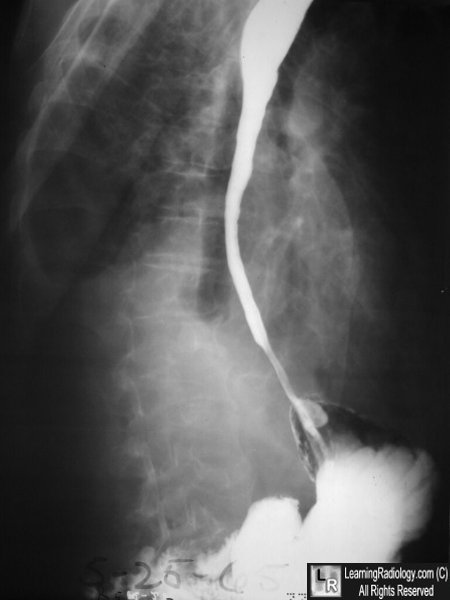|
|
Caustic Esophagitis
Lye Stricture
General Considerations
- Starting in 1967, lye (concentrated sodium hydroxide) became available as a liquid in drain cleaners and caustic esophagitis became a serious medical problem
- Other household agents which can produce caustic esophagitis are acids, ammonium chloride, phenols and silver nitrate
- Lye produces tissue damage through liquefaction necrosis as opposed to acids which produce coagulative necrosis. Both acidic and alkaline agents can damage esophagus.
- There are 3 phases to caustic esophagitis:
- The acute necrotic phase (1-4 days)
- The ulceration-granulation phase (3-5 days)*
- Fibrosis and stricture formation (3-4 weeks after ingestion)
- Esophagus most prone to perforate during this phase
- As little as 1cc of lye can produce full-thickness necrosis of the esophagus within 30 minutes of ingestion.
- Early changes are better evaluated with endoscopy than contrast studies
Imaging
- Mediastinal emphysema
- Left pleural effusion
- If a contrast study is done, water-soluble contrast is used in the cute phase
- Long, smooth esophageal strictures, usually in the distal esophagus
- About 20% have associated gastric abnormality, usually antral narrowing and ulceration
- In the acute phase, a water-soluble esophagram should be performed, followed by barium if no leak is seen.
Treatment
- Early treatment may include steroids, antibiotics and, some suggest, prophylactic dilatation. Still as many as 40% will develop strictures.
Prognosis
- There is a significantly higher risk of developing esophageal carcinoma 20-40 years after ingestion.
- Esophageal perforations may occur

Caustic Esophagitis. Image from a single-contrast barium swallow performed several years after the accidental ingestion of lye demonstrates a long, smooth distal esophageal stricture as evidenced by lack of normal distension of the esophagus.
|
|
|